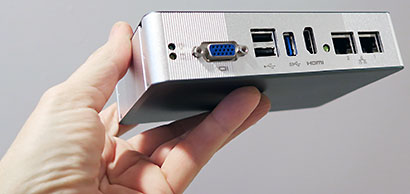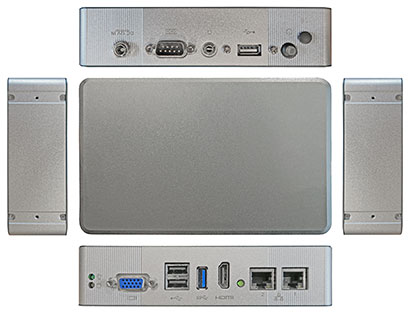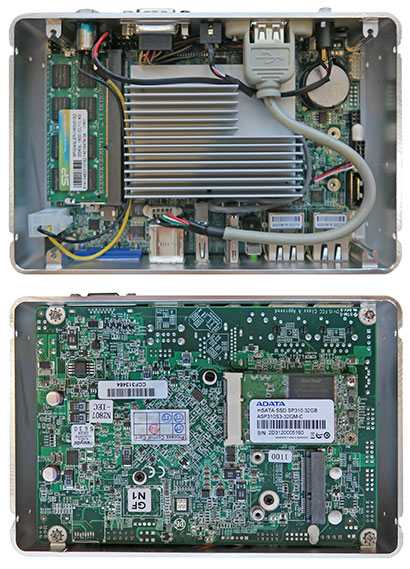|
ARBOR IEC-3300
Compact, rugged, fanless Intel Bay Trail-based Box PC for digital signage projects in transporation
(by Conrad H. Blickenstorfer)
ARBOR's IEC-3300, introduced June 2015, is a robust, fanless ultra-compact box PC. It's designed primarily for the transportation sector — with numerous deployment scenarios in cars, trucks, buses, and trains — but of interest to numerous other embedded and vertical markets as well. The device is impressively compact — just 6.4 x 4.3 inches and 1.54 inches tall. That's about half the volume of an Apple Mac Mini. And it also only weighs half as much as an Apple Mini. Yet, this is a tough, full-function, Intel Bay Trail-powered industrial Windows computer.

ARBOR's idea here was to create a very light and small industrial PC that doesn't need a fan, yet provides full Windows computing power and a nice complement of standard full-size onboard connectivity, including dual display capabiity to make it suitable for digital signage applications. The IEC-3300 is powered by either by a dual-core Intel N2807 or a quad-core Intel J1900 processor, both part of Intel's highly acclaimed "Bay Trail" processor platform. The device is available with up to 8GB of RAM, 16GB or 32GB of mSATA solid state disk, and there's a half-size mini PCI-e slot of additional expansion such as WiFi. The image below shows the ARBOR IEC-3300 from the top and all four sides.

In terms of design, the IEC-3300 represents rugged systems simplicity at its best. The housing consists of a rectangular section of 3/32-inch aluminum alloy. The roughly 5.5 x 4.0 inch motherboard is secured onto supports inside that aluminum chassis. The top and bottom of the device consist of identical precisely milled and superbly fitting bevelled aluminum alloy covers, secured in place by four small screws each. The pictures below show the insides of the IEC-3300 from the top and from the bottom.

The image on top shows the sole 204-pin SO-DIMM slot that comes with either a 4GB or an 8GB (depending on the processor) DDR3L RAM module; the finned heat sink that easily dissipates the heat generated by either one of the highly efficient Bay Trail processors without even needing to make contact with the aluminum top of the unit; the edge-mounted I/O along the bottom (two USB 2.0, a USB 3.0, HDMI, VGA, and dual RJ45 gigabit LAN jacks); and the additional wired-connected I/O along the top of the device (audio, power, RS232 serial, and another USB 2.0 port). Note the little dollops of silicone glue that keep connectors from coming loose due to vehicular vibration.
The image on the bottom shows the unit's mSATA expansion slot used for solid state mass storage, and below it the empty half-size mini PCIe slot available for expansion.
The two Intel Bay Trail Celeron chips ARBOR offers the IEC-3300 with are both similar and dissimilar. Similar in that both use the same processor architecture, lithography, and also the same integrated Intel HD Graphics. Dissimilar in that the N2807 is a dual-core/dual-thread chip designed for maximum economy, and the J1900 a quad-core/quad-thread chip that's significantly more performance-oriented. The table below shows both the similarities and the differences between the two chips:
|
Available Intel CPUs
|
Celeron
|
Celeron
|
|
Model
|
N2807
|
J1900
|
|
Code
|
"Bay Trail"
|
"Bay Trail"
|
|
Cores/Threads
|
2/2
|
4/4
|
|
Lithography
|
22mn
|
22mn
|
|
Base Clock Speed
|
1.58 GHz
|
2.16 GHz
|
|
Turbo Speed
|
2.16 GHz
|
2.42 GHz
|
|
Thermal Design Power (TDP)
|
4.3 watts
|
10 watts
|
|
Scenario Design Power (SDP)
|
2.5 watts
|
NA
|
|
Smart Cache
|
1MB
|
2MB
|
|
Max RAM
|
4GB
|
8GB
|
|
Integrated graphics
|
HD Graphics
|
HD Graphics
|
|
Graphics base speed
|
313 MHz
|
688 MHz
|
|
Graphics max speed
|
688 MHz
|
854 MHz
|
|
Intel Wireless Display
|
Yes
|
No
|
|
Intel vPro
|
No
|
No
|
Given that the J1900 is a quad-core design and runs at a high base and burst frequency, and also at a higher graphics speed, will the J1900 version absolutely trounce the N2807 version in terms of performance? Our evaluation IEC-3300 came with the N2807 chip and so we can't say with certainty how a J1900-equipped IEC-3300 will perform. However, we did recently test ARBOR's big 21-inch ASLAN W722C panel PC (see our review) that uses the J1900, and its performance is likely close enough to what users can expect from the J1900-based version of the IEC-3300 to be meaningful. The table below shows both the PassMark and the CrystallMark benchmark numbers for both:
|
Performance benchmarks
|
ARBOR IEC-3300
|
ARBOR ASLAN W722C
|
|
Processor
|
Celeron N2807
|
Celeron J1900
|
|
CPU Mark
|
781
|
1,731
|
|
2D Graphics Mark
|
163
|
203
|
|
Memory Mark
|
380
|
441
|
|
Disk Mark
|
1,260
|
1,135
|
|
3D Graphics Mark
|
132
|
146
|
|
Overall PassMark
|
570
|
820
|
|
CrystalMark ALU
|
14,827
|
29,365
|
|
CrystalMark FPU
|
12,422
|
25,799
|
|
CrystalMark MEM
|
16,577
|
23,515
|
|
CrystalMark HDD
|
28,269
|
27,262
|
|
CrystalMark GDI
|
4,336
|
6,154
|
|
CrystalMark D2D
|
3,735
|
3,362
|
|
CrystalMark OGL
|
3,674
|
4,025
|
|
Overall CrystalMark
|
83,840
|
119,482
|
So based on comparing the two chips in different (but similarly equipped) devices from the same company, yes, the J1900 version of the IEC-3300 is likely about 50% faster than the N2807 version. That's most noticeable in CPU-intensive operations (because the J1900 has twice as many computing cores), but less so in storage and graphics operations.
Now keep in mind that in embedded systems, and the IEC-3300 can be considered an embedded system, peak performance is of less importance than rock-steady reliability and being able to handle a series of well-known tasks. So if the N2807's performance is up to the tasks in an intended deployment, it may be the preferable choice because it runs cooler, and cooler almost always means more predictable performance and longer life cycle.
So what does that all mean, and what has this ultra-compact ARBOR industrial PC going for itself? First, it's very robust and very simple, and that's a big plus in embedded systems deployments. Second, its low-power processors and good thermal design mean the units can be deployed almost anywhere. Third, there's enough onboard I/O to have the units communicate with almost anything (dual-LAN, USB, legacy serial, etc.). Fourth, its dual display capability (VGA and HDMI) make it ideal for vehicular digital signage applications. And fifth, the price is attractively low.
All of this combines to make the ARBOR IEC-3300 a competent, dependable, and remarkably inexpensive building block for numerous embedded and vertical market systems projects in the transportation sector and beyond.
ARBOR Technology Corp.
www.arbor-technology.com
|


